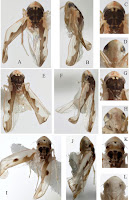Abstract
A new genus of tribe Erythroneurini from Thailand, Thaioneura gen. n., including three new species: Thaioneura nigrilinea sp. n. (type species), Thaioneura sinuata sp. n. and Thaioneura suphanburia sp. n., is described and illustrated and a key to species is provided. The new genus exhibits a pattern of interspecific variation in the hind wing venation that has not been observed in other genera of the tribe.
Keywords: Homoptera, Auchenorrhyncha, morphology, taxonomy, new taxa
Thaioneura gen. n.
Type species: Thaioneura nigrilinea sp. n.
Etymology: The new genus name was formed by combining the name of the country in which all known specimens were collected, “Thailand” with the common suffix for generic names in this tribe, “-neura”. The gender is feminine.
Discussion
Study of 31 leafhopper specimens representing 3 new species revealed that the new genus described here exhibits two different patterns of hind wing venation that are stable within species but variable between species. Hind wing vein CuA of Thaioneura nigrilinea separates from MP distally and is connected to CuP near the wing apex (Fig. 2). This is the usual venational pattern seen in the vast majority of Erythroneurini. However, the other two new species (Thaioneura sinuata; Thaioneura suphanburia) have vein CuA of the hind wing completely confluent with MP distally and vein CuP free distally (Figs 12, 22). This latter pattern also occurs in the Oriental genera Diomma Motschulsky (see Chiang and Knight 1990) and Watara Dworakowska. The two known species of Watara show the pattern consistently but some species of Diomma have CuA completely confluent with MP while others have these two veins divergent near the wing apex. Therefore, variation in hind wing venation is known to occur but is rare in other genera of Erythroneurini. Despite the observed variation in hind wing venation, placement of the three new species described here into a single genus is strongly justified by the unique dorsal color pattern and combination of features of the male genitalia. Nevertheless, the particular pattern of variation exhibited among Thaioneura species is not known to occur in other erythroneurine genera and further collecting and morphological study is needed to determine whether such variation occurs in other genera. The type species of Thaioneura, T. nigrilinea, has the usual venational pattern found in other Erythroneurini and, therefore, presumably represents the plesiomorphic condition for the new genus while the other two species are more apomorphic. This hypothesis should be tested by future phylogenetic analyses of Erythroneurini.
Yuehua Song, Zizhong Li and Christopher H. Dietrich. 2016. A New Erythroneurine Leafhopper Genus from Thailand (Hemiptera, Cicadellidae, Typhlocybinae), with Description of Three New Species. ZooKeys 595: 7-16. DOI: 10.3897/zookeys.595.8159

